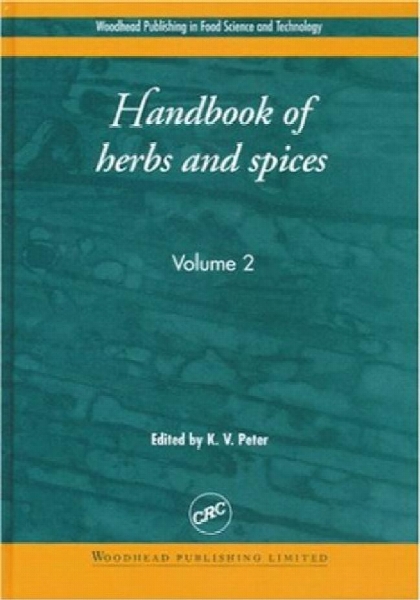Handbook of herbs and spices
- نوع فایل : کتاب
- زبان : انگلیسی
- مؤلف : K V Peter
- ناشر : Cambridge : Woodhead Pub
- چاپ و سال / کشور: 2004
- شابک / ISBN : 9781855738355
Description
List of contributors 1 Introduction K. V. Peter, Kerala Agricultural University, India and K. Nirmal Babu, Indian Institute of Spices Research, India 1.1 Introduction to herbs and spices 1.2 Uses of herbs and spices 1.3 Active plant constituents 1.4 The structure of this book 1.5 References Part I General issues 2 The functional role of herbal spices M. R. Shylaja and K. V. Peter, Kerala Agricultural University, India 2.1 Introduction 2.2 Classification 2.3 Production, consumption and processing 2.4 Functional properties 2.5 Sources of further information 3 Herbs and spices and antimicrobials C. C. Tassou, National Agricultural Research Foundation, Greece, and G.-J. E. Nychas and P. N. Skandamis, Agricultural University of Athens, Greece 3.1 Introduction 3.2 Barriers to the use of herb and spice essential oils as antimicrobials in foods 3.3 Measuring antimicrobial activity 3.4 Studies in vitro 3.5 Applications in food systems 3.6 Mode of action and development of resistance 3.7 Legislation © 2004, Woodhead Publishing Ltd vi Contents 3.8 Future prospects and multifactorial preservation 3.9 References 4 Screening for health effects of herbs R. Rodenburg, TNO Pharma, The Netherlands 4.1 Introduction 4.2 Types of assays 4.3 Throughput vs content assays 4.4 Assay quality 4.5 Screening bio-active compounds 4.6 Screening experiments for anti-inflammatory properties 4.7 Future trends 4.8 Sources of further information 4.9 References 5 Under-utilized herbs and spices P. N. Ravindran and Geetha S. Pillai, Centre for Medicinal Plants Research, India and K. Nirmal Babu, Indian Institute of Spices Research, India 5.1 Introduction 5.2 Sweet flag 5.3 Greater galangal 5.4 Angelica 5.5 Horseradish 5.6 Black caraway 5.7 Capers 5.8 Asafoetida 5.9 Hyssop 5.10 Galangal 5.11 Betel vine 5.12 Pomegranate 5.13 Summer savory 5.14 Winter savory 5.15 Other 5.16 References Part II Particular herbs and spices 6 Ajowan S. K. Malhotra and O. P. Vijay, National Research Centre on Seed Spices, India 6.1 Introduction and description 6.2 Production 6.3 Cultivation 6.4 Chemical structure 6.5 Main uses in food processing 6.6 Functional properties and toxicity 6.7 Quality issues 6.8 References © 2004, Woodhead Publishing Ltd Contents vii 7 Allspice B. Krishnamoorthy and J. Rema, Indian Institute of Spices Research, India 7.1 Introduction and description 7.2 Production and trade 7.3 Chemical composition 7.4 Cultivation 7.5 Uses 7.6 Functional properties 7.7 Quality issues and adulteration 7.8 References 8 Chervil A. A. Farooqi and K. N. Srinivasappa, University of Agricultural Sciences, India 8.1 Introduction and description 8.2 Cultivation and production technology 8.3 Uses 8.4 Sources of further information 9 Coriander M. M. Sharma and R.K. Sharma, Rajasthan Agricultural University, India 9.1 Introduction and description 9.2 Origin and distribution 9.3 Chemical composition 9.4 Cultivation and post-harvest practices 9.5 Uses 9.6 Diseases, pests and the use of pesticides 9.7 Quality issues 9.8 Value addition 9.9 Future research trends 9.10 References Appendix I Appendix II 10 Geranium M. T. Lis-Balchin, South Bank University, UK 10.1 Introduction 10.2 Chemical composition 10.3 Production and cultivation 10.4 Main uses in food processing and perfumery 10.5 Functional properties 10.6 Quality issues and adulteration 10.7 References 11 Lavender M. T. Lis-Balchin, South Bank University, UK 11.1 Introduction 11.2 Chemical composition 11.3 Production © 2004, Woodhead Publishing Ltd viii Contents 11.4 Uses in food processing, perfumery and paramedical spheres 11.5 Functional properties and toxicity 11.6 Quality issues and adulteration 11.7 References 12 Mustard J. Thomas, K. M. Kuruvilla and T. K. Hrideek, ICRI Spices Board, India 12.1 Introduction and description 12.2 Chemical composition 12.3 Production and cultivation 12.4 Uses 12.5 Properties 12.6 Quality specifications 12.7 References 13 Nigella S. K. Malhotra, National Research Centre on Seed Spices, India 13.1 Introduction and description 13.2 Chemical structure 13.3 Cultivation 13.4 Main uses in food processing 13.5 Functional properties and toxicity 13.6 Quality specifications and adulteration 13.7 References 14 Oregano S. E. Kintzios, Agricultural University of Athens, Greece 14.1 Introduction and description 14.2 Chemical structure 14.3 Production and cultivation 14.4 Main uses in food processing and medicine 14.5 Functional properties 14.6 Quality specifications and commercial issues 14.7 References 15 Parsley D. J. Charles, Frontier Natural Products, USA 15.1 Introduction and description 15.2 Chemical composition 15.3 Production and cultivation 15.4 Organic farming 15.5 General uses 15.6 Essential oils and their physicochemical properties 15.7 References 16 Rosemary B. Sasikumar, Indian Institute of Spices Research, India 16.1 Introduction and description 16.2 Chemical composition 16.3 Production and cultivation © 2004, Woodhead Publishing Ltd Contents ix 16.4 Post-harvest technology 16.5 Uses 16.6 Toxicology and disease 16.7 Conclusion 16.8 References 17 Sesame D. M. Hegde, Directorate of Oilseeds Research, India 17.1 Introduction 17.2 Chemical composition 17.3 Production 17.4 Processing 17.5 Uses 17.6 Future research needs 17.7 References 18 Star anise C. K. George, Peermade Development Society, India 18.1 Introduction, morphology and related species 18.2 Histology 18.3 Production and cultivation 18.4 Main uses 18.5 References 19 Thyme E. Stahl-Biskup, University of Hamburg, Germany and R. P. Venskutonis, Kaunas University of Technology, Lithuania 19.1 Introduction 19.2 Chemical structure 19.3 Production 19.4 Main uses in food processing 19.5 Functional properties and toxicity 19.6 Quality specifications and issues 19.7 References 20 Vanilla C. C. de Guzman, University of the Philippines Los Baños, Philippines 20.1 Introduction and description 20.2 Production and trade 20.3 Cultivation 20.4 Harvesting, yield and post-production activities 20.5 Uses 20.6 Vanilla products 20.7 Functional properties 20.8 Quality issues and adulteration 20.9 Improving production of natural vanillin 20.10 Future outlook 20.11 References © 2004,


